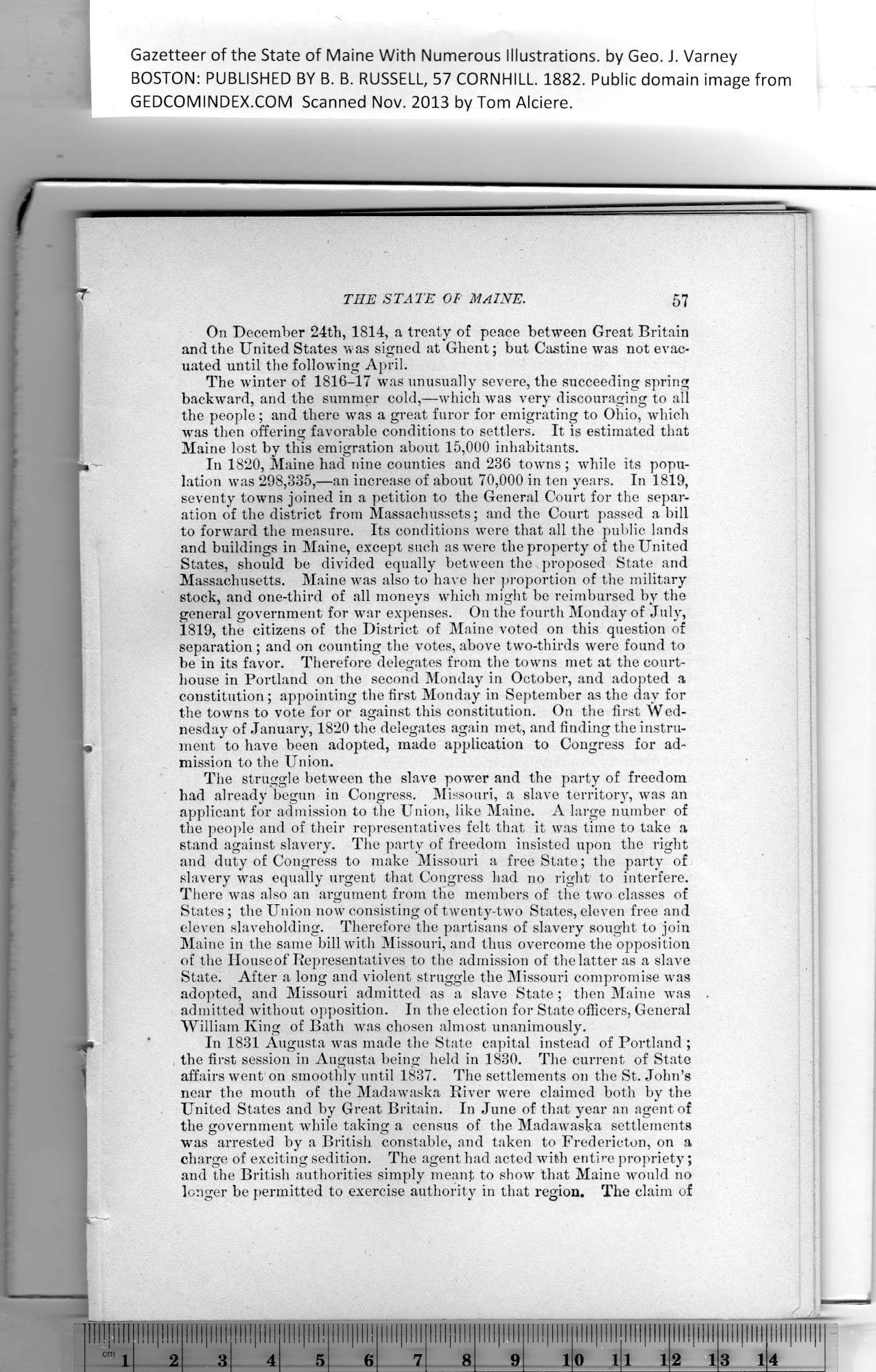|
Gazetteer of the State of Maine With Numerous Illustrations, by Geo. J. Varney
BOSTON: PUBLISHED BY B. B. RUSSELL, 57 CORNHILL. 1882. Public domain image from
THE STATE OF MAINE. 57
On December 24th, 1814, a treaty of peace between Great Britain
and the United States was signed at Ghent; but Castine was not evac-
uated until the following April.
The winter of 1816-17 was unusually severe, tbe succeeding spring
backward, and tbe summer cold,—which was very discouraging to all
the people; and there was a great furor for emigrating to Ohio, which
was then offering favorable conditions to settlers. It is estimated that
Maine lost by this emigration about 15,000 inhabitants.
In 1820, Maine had nine counties and 236 towns ; while its popu-
lation was 298,335,—an increase of about 70,000 in ten years. In 1819,
seventy towns joined in a petition to tbe General Court for the separ-
ation of the district from Massachussets; and the Court passed a bill
to forward tbe measure. Its conditions were that all the public lands
and buildings in Maine, except such as were the property of tbe United
States, should be divided equally between the proposed State and
Massachusetts. Maine was also to have her proportion of the military
stock, and one-third of all moneys which might be reimbursed by the
general government for war expenses. On the fourth Monday of July,
1819, the citizens of the District of Maine voted on this question of
separation; and on counting the votes, above two-thirds were found to
be in its favor. Therefore delegates from the towns met at the court-
house in Portland on the second Monday in October, and adopted a
constitution; appointing the first Monday in September as the day for
the towns to vote for or against this constitution. On the first Wed-
nesday of January, 1820 the delegates again met, and finding the instru-
ment to have been adopted, made application to Congress for ad-
mission to tbe Union.
The struggle between the slave power and the party of freedom
had already begun in Congress. Missouri, a slave territory, was an
applicant for admission to the Union, like Maine. A large number of
the people and of their representatives felt that it was time to take a
stand against slavery. The party of freedom insisted upon the right
and duty of Congress to make Missouri a free State; the party of
slavery was equally urgent that Congress had no right to interfere.
There was also an argument from the members of the two classes of
States ; the Union now consisting of twenty-two States, eleven free and
eleven slaveholding. Therefore the partisans of slavery sought to join
Maine in the same bill with Missouri, and thus overcome the opposition
of the House of Representatives to the admission of the latter as a slave
State. After a long and violent struggle the Missouri compromise was
adopted, and Missouri admitted as a slave State ; then Maine was
admitted without opposition. In the election for State officers, General
William King of Bath was chosen almost unanimously.
In 1831 Augusta was made the State capital instead of Portland ;
the first session in Augusta being held in 1830. The current of State
affairs went on smoothly until 1837. The settlements on tbe St. John’s
near the mouth of the Madawaska River were claimed both by the
United States and by Great Britain. In June of that year an agent of
the government while taking a census of the Madawaska settlements
was arrested by a British constable, and taken to Fredericton, on a
charge of exciting sedition. The agent bad acted with entire propriety;
and the British authorities simply meant to show that Maine would no
longer be permitted to exercise authority in that region. The claim of
PREVIOUS PAGE ... NEXT PAGE
This page was written in HTML using a program written in Python 3.2
|
